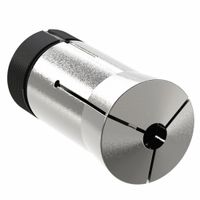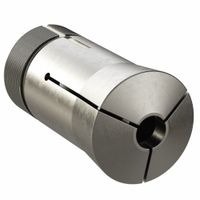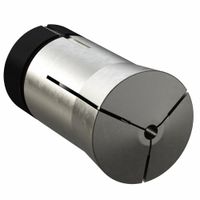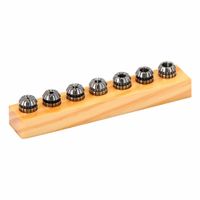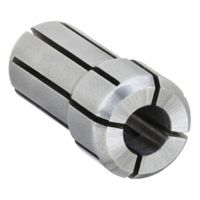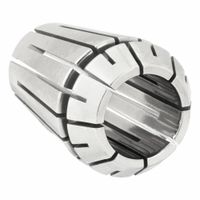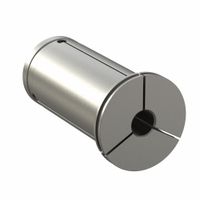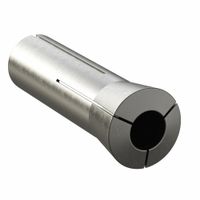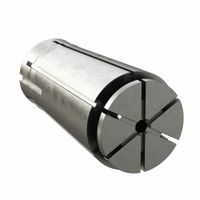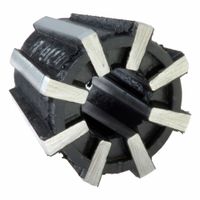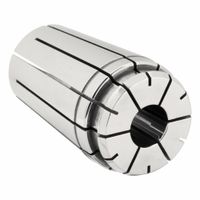Call +(254) 703 030 000 / 751 483 999 / 721 704 777
.....Read More
Frequently Asked Questions
What is a collet and how does it work?
A collet is a type of chuck that forms a collar around an object to be held and exerts a strong clamping force on the object when it is tightened. It is typically used to hold a tool or a workpiece in place during machining operations. Collets are commonly used in lathes, milling machines, and other precision machining equipment.
The collet is usually a cylindrical sleeve made of spring steel, which is slotted along its length to allow it to expand and contract. It is designed to fit into a tapered socket in the machine spindle or tool holder. When the collet is inserted into the socket, a drawbar or a nut is used to pull the collet into the taper, causing it to contract and grip the tool or workpiece securely.
Collets are available in various sizes and shapes to accommodate different tool shank diameters and workpiece dimensions. They provide a high level of precision and concentricity, making them ideal for applications requiring accurate alignment and minimal runout. The gripping force of a collet is distributed evenly around the circumference of the tool or workpiece, reducing the risk of damage and ensuring a stable hold.
In summary, a collet works by using a tapered design and a drawbar mechanism to apply uniform clamping pressure around a tool or workpiece, providing secure and precise holding for machining operations.
What are the different types of collets?
Collets are specialized types of chucks used to hold workpieces or tools in place, typically in machining operations. The different types of collets include:
1. **Spring Collets**: These are the most common type, made from spring steel, and are used for holding cylindrical workpieces. They contract when tightened, providing a firm grip.
2. **ER Collets**: Widely used in CNC machines, ER collets are versatile and can hold a range of tool sizes. They are known for their high precision and clamping force.
3. **5C Collets**: Commonly used in lathes and grinders, 5C collets are designed for holding small workpieces. They are known for their simplicity and ease of use.
4. **R8 Collets**: Typically used in milling machines, R8 collets are designed to hold tool shanks. They are known for their ability to provide a strong grip and easy tool changes.
5. **Rubber Flex Collets**: These collets use a rubber sleeve to grip the workpiece, allowing for a range of diameters to be held with a single collet. They are often used in lathes.
6. **Dead-Length Collets**: Designed to maintain a constant length of the workpiece during clamping, these collets are used in applications where precise length control is critical.
7. **Serrated Collets**: These have serrated jaws for gripping irregularly shaped workpieces, providing a secure hold in challenging applications.
8. **Step Collets**: Used for holding larger diameter workpieces, step collets have a stepped design that allows for a range of sizes to be accommodated.
9. **Expanding Collets**: These collets expand outward to grip the internal diameter of a workpiece, often used in applications where external surfaces need to be machined.
10. **Square and Hex Collets**: Designed to hold square or hexagonal workpieces, these collets are used in specialized machining operations.
Each type of collet is designed for specific applications, offering varying levels of precision, grip strength, and versatility.
How do you choose the right collet size?
To choose the right collet size, follow these steps:
1. **Determine the Tool Shank Diameter**: Measure the diameter of the tool shank you intend to use. This is the most critical factor, as the collet must match the tool shank size precisely for a secure fit.
2. **Check Collet Specifications**: Review the specifications of the collet system you are using. Collets are typically available in standard sizes, such as ER collets, which range from ER8 to ER50, each accommodating a specific range of tool shank diameters.
3. **Match the Collet to the Tool Shank**: Select a collet that matches the exact diameter of the tool shank. For example, if the tool shank is 6mm, choose a 6mm collet. Some collets can accommodate a small range of sizes, but for optimal performance, an exact match is preferred.
4. **Consider the Collet Type**: Different collet types (e.g., ER, R8, 5C) have different applications and compatibility with machines. Ensure the collet type is compatible with your machine's spindle.
5. **Check for Runout Tolerance**: Ensure the collet provides minimal runout to maintain precision in machining operations. High-quality collets offer better concentricity and grip.
6. **Inspect for Wear and Damage**: Before use, inspect the collet for any signs of wear or damage, which can affect performance and safety.
7. **Consult Manufacturer Guidelines**: Refer to the machine and collet manufacturer’s guidelines for specific recommendations and compatibility.
8. **Consider Future Needs**: If you frequently change tool sizes, consider a collet set that covers a range of sizes for flexibility.
By following these steps, you can ensure the collet size chosen provides a secure and precise fit for your machining needs.
How do you install and remove a collet?
To install a collet:
1. **Power Off**: Ensure the machine is powered off and unplugged for safety.
2. **Access the Spindle**: Open or remove any covers to access the spindle.
3. **Insert the Collet**: Place the collet into the collet nut. Ensure it clicks into place by slightly angling it and pressing until it snaps in.
4. **Attach the Collet Nut**: Thread the collet nut with the collet onto the spindle. Hand-tighten initially.
5. **Insert the Tool**: Slide the tool or bit into the collet. Ensure it is seated properly.
6. **Tighten the Collet Nut**: Use a wrench to tighten the collet nut securely, ensuring the tool is firmly held.
To remove a collet:
1. **Power Off**: Ensure the machine is powered off and unplugged.
2. **Loosen the Collet Nut**: Use a wrench to loosen the collet nut. Turn counterclockwise until the tool is free.
3. **Remove the Tool**: Once loose, carefully remove the tool or bit from the collet.
4. **Detach the Collet Nut**: Continue loosening the collet nut until it can be removed from the spindle.
5. **Remove the Collet**: Press the collet out of the collet nut. If it is stuck, gently tap it out using a soft mallet or similar tool.
6. **Inspect and Clean**: Check the collet and nut for wear or damage. Clean any debris or residue before reinstallation or storage.
Always follow the manufacturer's instructions specific to your machine model for best results and safety.
What are the advantages of using collets over other tool holding methods?
Collets offer several advantages over other tool holding methods:
1. **Precision and Accuracy**: Collets provide superior concentricity, ensuring that the tool is held precisely in the center. This reduces runout and enhances machining accuracy, which is crucial for high-precision applications.
2. **Grip Strength**: Collets offer a strong, uniform grip over the entire circumference of the tool, minimizing slippage and improving the stability of the tool during operation. This is particularly beneficial for high-speed machining.
3. **Versatility**: Collets can accommodate a range of tool sizes within a specific range, allowing for flexibility in tool selection without the need for multiple tool holders.
4. **Compact Design**: The compact size of collets makes them ideal for use in applications where space is limited. This can be advantageous in multi-axis machining centers where tool clearance is a concern.
5. **Ease of Use**: Collets are relatively easy to change and require minimal setup time, which can enhance productivity by reducing downtime during tool changes.
6. **Cost-Effectiveness**: Compared to other tool holding systems, collets are generally more affordable, making them a cost-effective solution for many machining operations.
7. **Vibration Damping**: The design of collets helps in damping vibrations during machining, which can improve surface finish and extend tool life.
8. **Wide Availability**: Collets are widely available and come in various sizes and types, such as ER, R8, and 5C, making them suitable for a broad range of applications and machines.
9. **Minimal Tool Wear**: The even distribution of clamping force reduces the risk of tool damage, extending the life of both the tool and the collet.
These advantages make collets a preferred choice in many machining environments, particularly where precision, efficiency, and cost are critical considerations.
How do you maintain and care for collets?
To maintain and care for collets, follow these steps:
1. **Regular Cleaning**: After each use, clean the collets thoroughly to remove any debris, dust, or residue. Use a soft brush or compressed air to clean the slots and surfaces.
2. **Inspection**: Regularly inspect collets for wear, damage, or corrosion. Look for signs of cracking, deformation, or excessive wear, which can affect performance and safety.
3. **Lubrication**: Apply a light coat of machine oil or a suitable lubricant to prevent rust and ensure smooth operation. Avoid over-lubrication, which can attract dust and debris.
4. **Proper Storage**: Store collets in a clean, dry environment. Use a collet rack or holder to keep them organized and prevent damage from contact with other tools or surfaces.
5. **Correct Usage**: Always use the correct size collet for the tool or workpiece. Over-tightening or using the wrong size can cause damage or reduce accuracy.
6. **Avoid Contamination**: Keep collets free from oil, grease, or coolant contamination, which can affect grip and precision.
7. **Replacement**: Replace collets that show signs of wear or damage. Using worn collets can lead to poor performance and potential safety hazards.
8. **Calibration**: Periodically check the calibration of collets to ensure they maintain the correct grip and alignment.
9. **Avoid Excessive Force**: Do not apply excessive force when tightening collets, as this can cause deformation or damage.
10. **Use Protective Equipment**: When handling collets, use gloves to prevent oils from your skin from causing corrosion.
By following these maintenance and care practices, collets will remain in good condition, ensuring precision and longevity in machining operations.
What are common problems with collets and how can they be fixed?
Common problems with collets include:
1. **Wear and Tear**: Over time, collets can wear out, leading to poor grip and reduced accuracy.
- **Fix**: Regularly inspect and replace worn collets. Use high-quality collets to extend lifespan.
2. **Improper Clamping**: If a collet is not clamping properly, it can cause tool slippage or damage.
- **Fix**: Ensure the collet is clean and free from debris. Tighten to the manufacturer's specifications.
3. **Misalignment**: Misalignment can cause runout, affecting precision.
- **Fix**: Check for proper seating and alignment. Use a dial indicator to ensure minimal runout.
4. **Over-tightening**: Excessive force can damage the collet or the tool.
- **Fix**: Use a torque wrench to apply the correct amount of force.
5. **Corrosion**: Exposure to moisture can lead to rust, affecting performance.
- **Fix**: Store collets in a dry environment and apply a rust inhibitor.
6. **Debris Accumulation**: Chips and dirt can prevent proper seating.
- **Fix**: Clean collets regularly with compressed air or a brush.
7. **Incorrect Size**: Using the wrong size collet can lead to poor performance.
- **Fix**: Always use the correct size collet for the tool shank.
8. **Fatigue**: Repeated use can cause material fatigue.
- **Fix**: Rotate collets in use and replace them periodically.
9. **Thermal Expansion**: Heat can cause expansion, affecting grip.
- **Fix**: Allow collets to cool before use and avoid excessive heat exposure.
10. **Improper Installation**: Incorrect installation can lead to inefficiency.
- **Fix**: Follow the manufacturer's installation guidelines carefully.
Regular maintenance and proper handling can mitigate these issues, ensuring optimal performance and longevity of collets.
